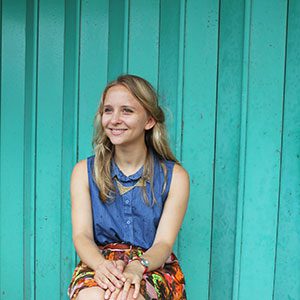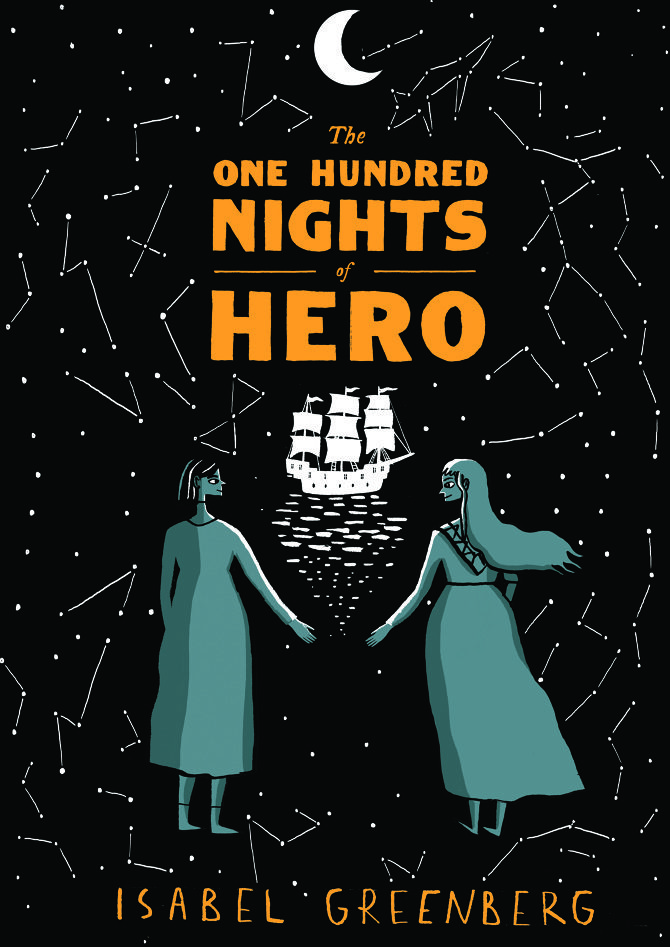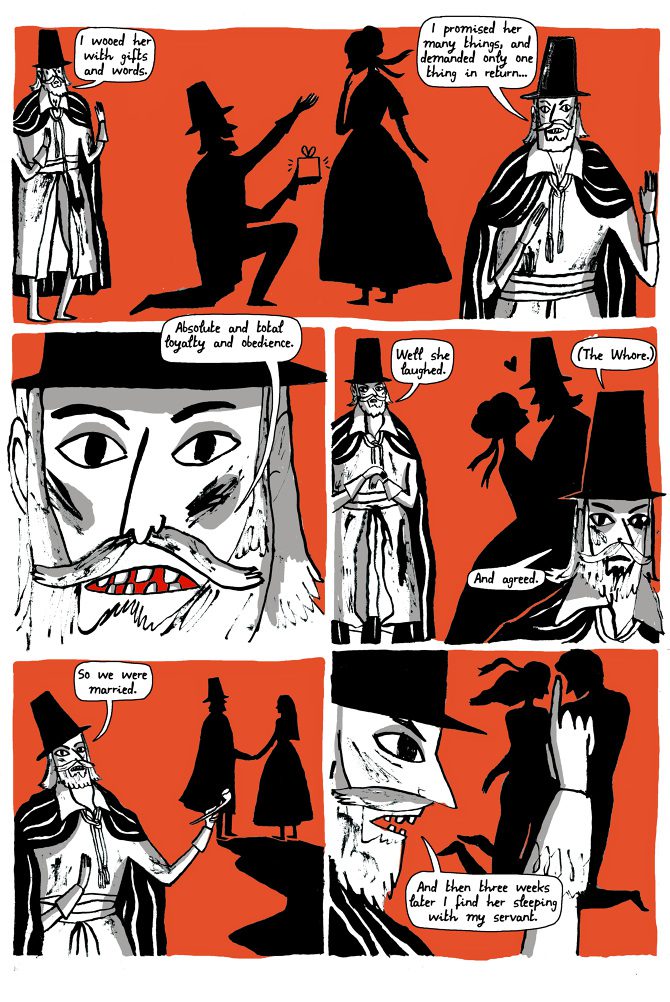
Isabel Greenberg is a London-based illustrator and writer. She studied illustration at the University of Brighton and has written for a variety of outlets including the Guardian, Nobrow Press, The National Trust, Seven Stories Press, and the New York Times. In 2011 she won the Observer/Jonathan Cape/Comica graphic short story prize. Her first graphic novel, The Encyclopedia of Early Earth, was published in 2013.
We talked through email about her second book, The One Hundred Nights of Hero, the premise of which is loosely based on Scheherazade’s One Thousand and One Nights. It starts with, “In the beginning was the world. And it was weird.” The book takes place in a medieval world created by a family of gods. Two men bet against the loyalty of one’s wife for one hundred nights. If he can seduce her by then, he’ll win the husband’s castle. They don’t know Cherry and her maid, Hero, are secretly lovers. Hero and Cherry make a plan: Hero, a member of the League of Secret Storytellers, will tell stories to fend the man off. Each night, Hero tells a different story of loyalty and love, treachery, and madness.
***
The Rumpus: How did this project begin? How long did this book take you to create?
Isabel Greenberg: It took about two years from conception of the idea to finishing it. There were a few starts and stops—it was initially going to be a totally different book, not set in Early Earth at all. But then I realized actually I was pretty keen to revisit that world.
Rumpus: What was it about the Early Earth that made you want to revisit this place?
Greenberg: I guess I feel like I began to build this world, and I wasn’t anywhere near to scratching the surface with the first book! Also, the freedom of setting something in an imagined world is that you can say and do what you like, and people can’t accuse you of flouting the conventions of science or fact! I think this makes it an interesting place to think about the things I want to say about our world. I was also fond of some of the characters, the gods, and wanted to return to them. When I first began, it was going to be a sequel almost all about them. But then my ideas changed, and they hardly make an appearance now. I really love Hero and Cherry, though. I would like to write something else about them, but I think maybe I covered their story fairly thoroughly—maybe one day. I’m going to take a break from Early Earth for the next thing I do, though.
Rumpus: What role did storytelling play in your childhood?
Greenberg: Storytelling and reading were extremely formative for me when I was growing up.
Rumpus: How so?
Greenberg: I was a big reader, and the stuff I enjoyed as a child still absolutely feeds into my work and ideas now: Tolkien, Ursula LeGuin, Phillip Pullman, Joan Aitken. I would say the books I read growing up have been my biggest influence. I liked books that had fully formed worlds, sometimes even maps. Absolutely this was something I wanted to bring into my own work.
My mum is a writer, and so are a lot of her family. She definitely encouraged my sister and I to write our own stories. And she would make them up for us too.
So there were a lot of books, and a lot of stories. She would invent stories about my sister and me when we were on holiday, things like that. Certainly the things I read growing up still influence me today: Ursula Le Guin, Phillip Pullman, J.R.R. Tolkien, Dianna Wynne Jones, The Brontes, Joan Aitken.
Rumpus: Do you have any rituals you use before you begin writing or drawing?
Greenberg: I don’t think so! I’m a daytime worker though, and I try and start early. So I guess breakfast and coffee! Depending on what I am working on, I would probably listen to a podcast or an audio book whilst I work. It also depends where I’m working. I used to have a studio, and I liked to walk there (it was nearly an hour), so that was a really good morning routine. Now I’m working at home, so sometimes I go for a swim first.
Rumpus: Where did the idea for the League of Secret Storytellers come from?
Greenberg: It was actually something my mum said to me, about secret societies of storytellers. I’m very interest in the idea of storytelling for survival.
Rumpus: What was your childhood like? What role did drawings play in your childhood?
Greenberg: Yes I was a very keen drawer my whole childhood. I wasn’t into comics though, so it wasn’t until I was a teenager that I thought about that as a potential for bringing the words and stories together. I had thought the only way I could do that was children’s books. It was very exciting to discover comics.
Rumpus: How do you decide when to stop writing and to let the images take on the weight of one part, and vice versa?
Greenberg: I try and get a substantial chunk of the story, if not written, then at the very least plotted out. I often write out sections in prose, like a story rather than a comic, and then plot it into rough pencils. At this point I can cut out surplus description. But I tend not to plot the whole thing out before starting to draw. I draw for a bit, then go back and pencil again. I like to write a lot, so sometimes my work can be quite text heavy. I have to remind myself that the pictures sometimes can tell the story.
***
Author photograph © Lydia Garnett.







